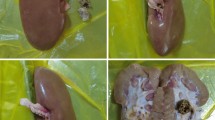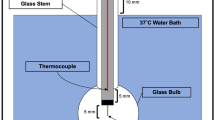Abstract
Purpose
To evaluate the thermal profiles of the holmium laser at different laser parameters at different locations in an in vitro anatomic pelvicalyceal collecting system (PCS) model. Laser lithotripsy is the cornerstone of treatment for urolithiasis. With the prevalence of high-powered lasers, stone ablation efficiency has become more pronounced. Patient safety remains paramount during surgery. It is well recognized that the heat generated from laser lithotripsy has the potential to cause thermal tissue damage.
Methods
Utilizing high-fidelity, 3D printed hydrogel models of a PCS with a synthetic BegoStone implanted in the renal pelvis, laser lithotripsy was performed with the Moses 2.0 holmium laser. At a standard power (40 W) and irrigation pressure (100 cm H2O), we evaluated operator duty cycle (ODC) variations with different time-on intervals at four different laser settings. Temperature was measured at two separate locations—at the stone and away from the stone.
Results
Temperatures were highest closest to the laser tip with a decrease away from the laser. Fluid temperatures increased with longer laser-on times and higher ODCs. Thermal doses were greater with increased ODCs and the threshold for thermal injury was reached for ODCs of 75% and 100%.
Conclusion
Temperature generation and thermal dose delivered are greatest closer to the tip of the laser fiber and are not dependent on power alone. Significant temperature differences were noted between four laser settings at a standardized power (40 W). Temperatures can be influenced by a variety of factors, such as laser-on time, operator duty cycle, and location in the PCS.

Similar content being viewed by others
Data Availability
The data collection has been included as a supplementary file.
Abbreviations
- RIRS:
-
Retrograde intrarenal surgery
- Ho: YAG:
-
Holmium: Yttrium–Aluminum–Garnet
- TD43 :
-
Thermal dose threshold of injury at 43 °C
- CEM:
-
Cumulative equivalent
- URS:
-
Ureteroscopy
- PCS:
-
Pelvicalyceal collecting system
- CFD:
-
Computational fluid dynamics
- PVA:
-
Polyvinyl alcohol
- ODC:
-
Operator duty cycle
- DICOM:
-
Digital imaging and communications in medicine
- CAD:
-
Computer-aided design
- UPJ:
-
Ureteropelvic junction
References
Kronenberg P, Somani B (2018) Advances in lasers for the treatment of stones-a systematic review. Curr Urol Rep 19(6):45
Chan KF et al (1999) Holmium:YAG laser lithotripsy: a dominant photothermal ablative mechanism with chemical decomposition of urinary calculi. Lasers Surg Med 25(1):22–37
Zarrabi A, Gross AJ (2011) The evolution of lasers in urology. Ther Adv Urol 3(2):81–89
Zhang JJ et al (2015) Water content contribution in calculus phantom ablation during Q-switched Tm:YAG laser lithotripsy. J Biomed Opt 20(12):128001
Rice P et al (2022) Generated temperatures and thermal laser damage during upper tract endourological procedures using the holmium: yttrium–aluminum–garnet (Ho:YAG) laser: a systematic review of experimental studies. World J Urol 40(8):1981–1992
Sapareto SA, Dewey WC (1984) Thermal dose determination in cancer therapy. Int J Radiat Oncol Biol Phys 10(6):787–800
Maxwell AD et al (2019) Simulation of laser lithotripsy-induced heating in the urinary tract. J Endourol 33(2):113–119
Aldoukhi AH et al (2017) Thermal response to high-power holmium laser lithotripsy. J Endourol 31(12):1308–1312
Ghazi A, Melnyk R, Cook A et al (2022) PD37–06 Comparison of computational simulation and hydrogel kidney phantoms for in vivo assessment of intrarenal pressure (IRP) dynamics during ureteroscopy under various experimental conditions. J Urol 207:e641
Saba P et al (2020) Development of a high-fidelity robot-assisted kidney transplant simulation platform using three-dimensional printing and hydrogel casting technologies. J Endourol 34(10):1088–1094
Braunstein L et al (2022) Characterization of acoustic, cavitation, and thermal properties of poly(vinyl alcohol) hydrogels for use as therapeutic ultrasound tissue mimics. Ultrasound Med Biol 48(6):1095–1109
Aldoukhi AH et al (2020) Defining thermally safe laser lithotripsy power and irrigation parameters. J Endourol 34(1):76–81
Louters MM et al (2022) Laser operator duty cycle effect on temperature and thermal dose: in-vitro study. World J Urol 40(6):1575–1580
Dau JJ et al (2021) Effect of chilled irrigation on caliceal fluid temperature and time to thermal injury threshold during laser lithotripsy. J Endourol 35(5):700–705
Aldoukhi AH et al (2021) Patterns of laser activation during ureteroscopic lithotripsy: effects on caliceal fluid temperature and thermal dose. J Endourol 35(8):1217–1222
De Coninck V, Defraigne C, Traxer O (2022) Watt determines the temperature during laser lithotripsy. World J Urol 40(5):1257–1258
Petzold R, Suarez-Ibarrola R, Miernik A (2021) Temperature assessment of a novel pulsed thulium solid-state laser compared with a holmium:yttrium–aluminum–garnet laser. J Endourol 35(6):853–859
Molina WR et al (2021) Temperature rise during ureteral laser lithotripsy: comparison of super pulse thulium fiber laser (SPTF) vs high power 120 W holmium-YAG laser (Ho:YAG). World J Urol 39(10):3951–3956
Dauw CA et al (2015) Contemporary practice patterns of flexible ureteroscopy for treating renal stones: results of a worldwide survey. J Endourol 29(11):1221–1230
Yarmolenko PS et al (2011) Thresholds for thermal damage to normal tissues: an update. Int J Hyperth 27(4):320–343
Aldoukhi AH et al (2018) Caliceal fluid temperature during high-power holmium laser lithotripsy in an in vivo porcine model. J Endourol 32(8):724–729
Acknowledgements
The authors would like to graciously thank Dr. William Roberts, MD from the University of Michigan for providing his expertise, input, and guidance in our project. The authors are largely based our project on the excellent work his lab has produced. He reviewed our data and provided insight for data evaluation to provide impactful results.
Funding
There was no source of funding for this project.
Author information
Authors and Affiliations
Contributions
CW: project development, data collection, data analysis, and manuscript writing; AS: data collection and data analysis; DP: data analysis and manuscript writing; KD: data analysis and manuscript writing; LS: project development, data collection, and data analysis; NS: project development, data collection, and data analysis; TO: project development and manuscript writing; SQ: project development and data analysis; AG: project development, data collection, and data analysis. All of the listed authors have contributed substantially to the production of this research and manuscript.
Corresponding author
Ethics declarations
Conflict of interest
There are no conflicts of interest nor are there any financial or non-financial interests of any author for any author included in the production of this manuscript.
Human or animals rights
This research project does not involve any human participants nor animal studies.
Informed consent
Informed consent was not required for this study.
Additional information
Publisher's Note
Springer Nature remains neutral with regard to jurisdictional claims in published maps and institutional affiliations.
Supplementary Information
Below is the link to the electronic supplementary material.
Rights and permissions
Springer Nature or its licensor (e.g. a society or other partner) holds exclusive rights to this article under a publishing agreement with the author(s) or other rightsholder(s); author self-archiving of the accepted manuscript version of this article is solely governed by the terms of such publishing agreement and applicable law.
About this article
Cite this article
Wanderling, C., Saxton, A., Phan, D. et al. WATTS happening? Evaluation of thermal dose during holmium laser lithotripsy in a high-fidelity anatomic model. World J Urol 42, 157 (2024). https://doi.org/10.1007/s00345-024-04821-9
Received:
Accepted:
Published:
DOI: https://doi.org/10.1007/s00345-024-04821-9




